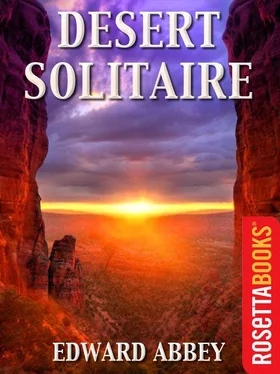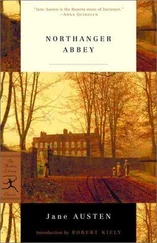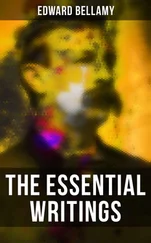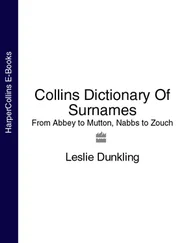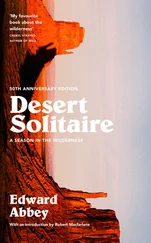Abbey, Edward - Desert Solitaire (Edward Abbey Series )
Здесь есть возможность читать онлайн «Abbey, Edward - Desert Solitaire (Edward Abbey Series )» — ознакомительный отрывок электронной книги совершенно бесплатно, а после прочтения отрывка купить полную версию. В некоторых случаях можно слушать аудио, скачать через торрент в формате fb2 и присутствует краткое содержание. Год выпуска: 2011, Издательство: RosettaBooks, Жанр: Старинная литература, на английском языке. Описание произведения, (предисловие) а так же отзывы посетителей доступны на портале библиотеки ЛибКат.
- Название:Desert Solitaire (Edward Abbey Series )
- Автор:
- Издательство:RosettaBooks
- Жанр:
- Год:2011
- ISBN:нет данных
- Рейтинг книги:4 / 5. Голосов: 1
-
Избранное:Добавить в избранное
- Отзывы:
-
Ваша оценка:
- 80
- 1
- 2
- 3
- 4
- 5
Desert Solitaire (Edward Abbey Series ): краткое содержание, описание и аннотация
Предлагаем к чтению аннотацию, описание, краткое содержание или предисловие (зависит от того, что написал сам автор книги «Desert Solitaire (Edward Abbey Series )»). Если вы не нашли необходимую информацию о книге — напишите в комментариях, мы постараемся отыскать её.
Desert Solitaire (Edward Abbey Series ) — читать онлайн ознакомительный отрывок
Ниже представлен текст книги, разбитый по страницам. Система сохранения места последней прочитанной страницы, позволяет с удобством читать онлайн бесплатно книгу «Desert Solitaire (Edward Abbey Series )», без необходимости каждый раз заново искать на чём Вы остановились. Поставьте закладку, и сможете в любой момент перейти на страницу, на которой закончили чтение.
Интервал:
Закладка:
For myself I’ll take Moab, Utah. I don’t mean the town itself, of course, but the country which surrounds it—the canyonlands. The slickrock desert. The red dust and the burnt cliffs and the lonely sky—all that which lies beyond the end of the roads.
The choice became apparent to me this morning when I stepped out of a Park Service housetrailer—my caravan—to watch for the first time in my life the sun come up over the hoodoo stone of Arches National Monument.
I wasn’t able to see much of it last night. After driving all day from Albuquerque—450 miles—I reached Moab after dark in cold, windy, clouded weather. At park headquarters north of town I met the superintendent and the chief ranger, the only permanent employees, except for one maintenance man, in this particular unit of America’s national park system. After coffee they gave me a key to the housetrailer and directions on how to reach it; I am required to live and work not at headquarters but at this one-man station some twenty miles back in the interior, on my own. The way I wanted it, naturally, or I’d never have asked for the job.
Leaving the headquarters area and the lights of Moab, I drove twelve miles farther north on the highway until I came to a dirt road on the right, where a small wooden sign pointed the way: Arches National Monument Eight Miles. I left the pavement, turned east into the howling wilderness. Wind roaring out of the northwest, black clouds across the stars—all I could see were clumps of brush and scattered junipers along the roadside. Then another modest signboard:
WARNING: QUICKSAND
DO NOT CROSS WASH
WHEN WATER IS RUNNING
The wash looked perfectly dry in my headlights. I drove down, across, up the other side and on into the night. Glimpses of weird humps of pale rock on either side, like petrified elephants, dinosaurs, stone-age hobgoblins. Now and then something alive scurried across the road: kangaroo mice, a jackrabbit, an animal that looked like a cross between a raccoon and a squirrel—the ringtail cat. Farther on a pair of mule deer started from the brush and bounded obliquely through the beams of my lights, raising puffs of dust which the wind, moving faster than my pickup truck, caught and carried ahead of me out of sight into the dark. The road, narrow and rocky, twisted sharply left and right, dipped in and out of tight ravines, climbing by degrees toward a summit which I would see only in the light of the coming day.
Snow was swirling through the air when I crossed the unfenced line and passed the boundary marker of the park. A quarter-mile beyond I found the ranger station—a wide place in the road, an informational display under a lean-to shelter, and fifty yards away the little tin government housetrailer where I would be living for the next six months.
A cold night, a cold wind, the snow falling like confetti. In the lights of the truck I unlocked the housetrailer, got out bedroll and baggage and moved in. By flashlight I found the bed, unrolled my sleeping bag, pulled off my boots and crawled in and went to sleep at once. The last I knew was the shaking of the trailer in the wind and the sound, from inside, of hungry mice scampering around with the good news that their long lean lonesome winter was over—their friend and provider had finally arrived.
This morning I awake before sunrise, stick my head out of the sack, peer through a frosty window at a scene dim and vague with flowing mists, dark fantastic shapes looming beyond. An unlikely landscape.
I get up, moving about in long underwear and socks, stooping carefully under the low ceiling and lower doorways of the housetrailer, a machine for living built so efficiently and compactly there’s hardly room for a man to breathe. An iron lung it is, with windows and Venetian blinds.
The mice are silent, watching me from their hiding places, but the wind is still blowing and outside the ground is covered with snow. Cold as a tomb, a jail, a cave; I lie down on the dusty floor, on the cold linoleum sprinkled with mouse turds, and light the pilot on the butane heater. Once this thing gets going the place warms up fast, in a dense unhealthy way, with a layer of heat under the ceiling where my head is and nothing but frigid air from the knees down. But we’ve got all the indispensable conveniences: gas cookstove, gas refrigerator, hot water heater, sink with running water (if the pipes aren’t frozen), storage cabinets and shelves, everything within arm’s reach of everything else. The gas comes from two steel bottles in a shed outside; the water comes by gravity flow from a tank buried in a hill close by. Quite luxurious for the wilds. There’s even a shower stall and a flush toilet with a dead rat in the bowl. Pretty soft. My poor mother raised five children without any of these luxuries and might be doing without them yet if it hadn’t been for Hitler, war and general prosperity.
Time to get dressed, get out and have a look at the lay of the land, fix a breakfast. I try to pull on my boots but they’re stiff as iron from the cold. I light a burner on the stove and hold the boots upside down above the flame until they are malleable enough to force my feet into. I put on a coat and step outside. Into the center of the world, God’s navel, Abbey’s country, the red wasteland.
The sun is not yet in sight but signs of the advent are plain to see. Lavender clouds sail like a fleet of ships across the pale green dawn; each cloud, planed flat on the wind, has a base of fiery gold. Southeast, twenty miles by line of sight, stand the peaks of the Sierra La Sal, twelve to thirteen thousand feet above sea level, all covered with snow and rosy in the morning sunlight. The air is dry and clear as well as cold; the last fogbanks left over from last night’s storm are scudding away like ghosts, fading into nothing before the wind and the sunrise.
The view is open and perfect in all directions except to the west where the ground rises and the skyline is only a few hundred yards away. Looking toward the mountains I can see the dark gorge of the Colorado River five or six miles away, carved through the sandstone mesa, though nothing of the river itself down inside the gorge. Southward, on the far side of the river, lies the Moab valley between thousand-foot walls of rock, with the town of Moab somewhere on the valley floor, too small to be seen from here. Beyond the Moab valley is more canyon and tableland stretching away to the Blue Mountains fifty miles south. On the north and northwest I see the Roan Cliffs and the Book Cliffs, the two-level face of the Uinta Plateau. Along the foot of those cliffs, maybe thirty miles off, invisible from where I stand, runs U.S. 6–50, a major east-west artery of commerce, traffic and rubbish, and the main line of the Denver-Rio Grande Railroad. To the east, under the spreading sunrise, are more mesas, more canyons, league on league of red cliff and arid tablelands, extending through purple haze over the bulging curve of the planet to the ranges of Colorado—a sea of desert.
Within this vast perimeter, in the middle ground and foreground of the picture, a rather personal demesne, are the 33,000 acres of Arches National Monument of which I am now sole inhabitant, usufructuary, observer and custodian.
What are the Arches? From my place in front of the housetrailer I can see several of the hundred or more of them which have been discovered in the park. These are natural arches, holes in the rock, windows in stone, no two alike, as varied in form as in dimension. They range in size from holes just big enough to walk through to openings large enough to contain the dome of the Capitol building in Washington, D.C. Some resemble jug handles or flying buttresses, others natural bridges but with this technical distinction: a natural bridge spans a watercourse—a natural arch does not. The arches were formed through hundreds of thousands of years by the weathering of the huge sandstone walls, or fins, in which they are found. Not the work of a cosmic hand, nor sculptured by sand-bearing winds, as many people prefer to believe, the arches came into being and continue to come into being through the modest wedging action of rainwater, melting snow, frost, and ice, aided by gravity. In color they shade from off-white through buff, pink, brown and red, tones which also change with the time of day and the moods of the light, the weather, the sky.
Читать дальшеИнтервал:
Закладка:
Похожие книги на «Desert Solitaire (Edward Abbey Series )»
Представляем Вашему вниманию похожие книги на «Desert Solitaire (Edward Abbey Series )» списком для выбора. Мы отобрали схожую по названию и смыслу литературу в надежде предоставить читателям больше вариантов отыскать новые, интересные, ещё непрочитанные произведения.
Обсуждение, отзывы о книге «Desert Solitaire (Edward Abbey Series )» и просто собственные мнения читателей. Оставьте ваши комментарии, напишите, что Вы думаете о произведении, его смысле или главных героях. Укажите что конкретно понравилось, а что нет, и почему Вы так считаете.
